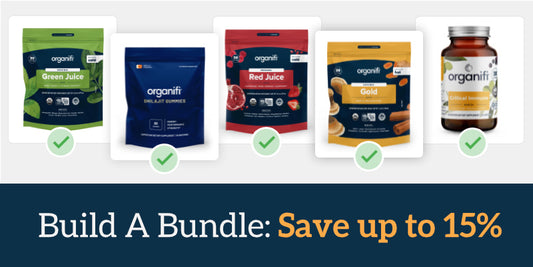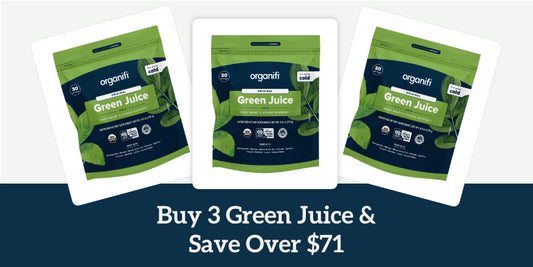This list of winter vegetables could support your immune system during the colder months, with high vitamin, mineral, and polyphenol content that feeds your antioxidant forces with a variety of flavor and zest.
We know the colder it gets the more appealing takeout, pasta, and easy dishes get, so we put together a list of twenty seasonal and local winter vegetables (all can be sourced from California) that have significant nutritional value to help you weather the cold - without betraying your health goals.
To make things easier, we added easy 15 to 20-minute recipes that you can make with one or more ingredients in the list and double-checked the Seasonality Chart provided by the non-profit CUESA that empowers local and seasonal farming.
These fall and winter veggies will keep you warm, healthy, and satisfied!
We hope you’re hungry and ready to fill your pantry with some of the best foods nature has to offer at this time of the year. Plus: it’s not all pumpkins!
20 Delicious Fall & Winter Vegetables
Below our top 20 veggies to roast up this fall and winter and why they could help you stay on track with your health and fitness goals.
#1 Beets:
Available year-round, we think they are the perfect roasted winter vegetable because they may boost the immune system and promote natural liver detox. Why? In every 100 grams, they have 8% the recommended daily intake value (RDI) of Vitamin C, 4% Iron, 5% Vitamin B-6 and 5% magnesium.
Eat them: warm and cold salads, try roasting them with this balsamic glaze for a beet detox after parties.
#2 Brussels Sprouts:
A member of the cruciferous family it’s a small and mighty winter vegetable; they grow and develop during the winter months and can withstand below 0 temperatures. We love it because just one cup has 136% RDI of Vitamin K, which is critical in blood coagulation, brain function, and cardiovascular health.
Vitamin K is one of the best aids against bloody noses from winter colds. They’re also rich in Vitamin A, C, and B6.
Eat them: roasted or sauteed, or in this 15-minute shredded brussel sprout stir fry, that also has the benefits of turmeric and ginger. By Holy Cow Vegan.
#3 Carrots:
Carrots provide a small amount of almost every essential vitamin, they’re available year-round but make the list because they’re just as great warm as they are raw. The health benefits of carrots usually come from their high Vitamin A content - just one cup provides 428% the recommended daily value.
Eat them: in delicious ABC juice (apples, beets, and carrots - all winter vegetables) or in this Epicurious winter Morrocan squash and carrot stew.
#4 Cauliflower:
Cauliflower provides a lot of hydration to your day; it’s 92.07% water per 100 grams. Part of the cruciferous family, it also has 299 gr of potassium, 48.2 gr of Vitamin C and 15.5 µg of Vitamin K.
Eat it: in this surprisingly tasty cauliflower toast, roasted or baked.
#5 Celery:
One of our favorite green juice ingredients, this may surprise you as it doesn’t feel much like a wintery green. However, it’s in season from April to December. It’s an excellent source of potassium, fiber, folate, and Vitamins K and A.
Eat it: in celery juice or added to warm salads for zest.
Winter months make keeping up with your juicing routines a bit harder, especially when you want to eat local and seasonal. If you get tired of celery juice, switch it up with our thyroid-friendly Organifi Green Juice.
#6 Chard:
Often called Swiss chard, it’s a fantastic seasonal veggie that tastes a lot sweeter when cooked. One cup has 53% RDI of Vitamin C, 716% of Vitamin K and 10% of calcium. Rich in other vitamins and minerals, we love it for its high antioxidant power.
Fun fact: it’s a winter vegetable with no connection to Switzerland other than it was cataloged by a Swiss botanist named Karl Koch.
Eat it: lightly sauteed, or in this wonderful potluck-friendly creamy Swiss Chard with Coconut recipe from Martha Stewart.
#7 Chicory:
An interesting recent addition to coffee, chicory is grown and harvested all year long. You can eat both the root and the leaves to leverage its surprising Vitamin K, A, C, E, and B6 content.
Eat it: sauteed or fresh in fall-appropriate salads like this Chicory, Orange, and Pomegranate seasonal treat from Food52.
#8 Collard Greens:
It’s one of the dark leafy greens we love to add to our fillings because of their calcium content. 100 gr of collard greens have 23-27% the recommended daily dose of calcium, 100% of Vitamin A, 58% of Vitamin C and 10% Vitamin B-6.
Eat them: boiled, drained, in soups, or in these superfood veggie rolls featuring turmeric rice, from the Will Cook for Friends blog.
#9 Kale:
Everyone’s favorite supergreen! Every 100 gr of kale has 4.3 gr of protein, 200% the recommended Vitamin C dose, and 199% Vitamin K. If you add to that 8% of the iron we need per day, plus 15% calcium - you can see why we love it!
Eat it: in this sneaky chocolate-kale smoothie that even kids love, or lightly sauteed in water with garlic to tame its bitter flavor.
#10 Kohlrabi:
It’s a funky looking winter vegetable with impressive nutrient density. Particularly high anthocyanins, phenolic compounds with potent antioxidant and anti-inflammatory properties, they make an interesting addition to your roasted dish. It also boasts 93% RDI for Vitamin C and 12% RDI for Vitamin B6.
Eat it: roasted, boiled, sauteed, baked, or raw. If it’s your first time trying them, the Spruce Eats has a 101 Kohlrabi Guide.
#11 Parsnips:
I know what you’re thinking - “what is a parsnip?” Like kohlrabi, this nutty-flavored and highly nutritious food is often overlooked. They’re rich in folate, fiber, Vitamin C, K, E (for better winter skin) and magnesium, which makes their filling nature extra healthy.
Eat them: in soups, stews, baked with other roasted winter vegetables. If you have the time, these parsnip soup and chips are to die for.
#12 Radicchio
Primarily a good source of Vitamin K, it adds color to salads and warm dishes sprinkled on top. The micronutrient content is varied and that’s why it makes the list. It has Vitamin C, E, B6, folate, riboflavin, pantothenic acid, and niacin.
Eat it: as a surprising roasted winter vegetable! It gets less bitter and we love California Grown’s Roasted Radicchio Wedges recipe.
#13 Radishes
Yes! They’re also seasonal in the winter. They make the list despite their rather modest nutritional value when compared to others on the list because they’re super low-calorie and could help fight Candida Albicans, a yeast that thrives on sugar.
Eat them: raw, in salads, boiled, roasted.
#14 Romanesco
A broccoli cousin, it makes the list due to its protein content; there are 4g of protein per 100 gr or 8% RDI. That may not seem like a lot, but most vegetables don’t make it past two, so it’s a nice addition to your winter roasted vegetable menu.
Eat it: roasted, baked, sauteed, hidden in green smoothies!
#15 Rutabagas
A nutrient-dense food that is rich in fiber, potassium, magnesium, calcium, Vitamin C and E. They’re a gentle cross between a parsnip and cabbage, which makes them an interesting alternative to mashed potatoes.
Eat them: in your roasted winter vegetable mix, boiled in soup or mashed. We love the Roasted Root’s Mashed Rutabaga with caramelized onions.
#16 Sprouts
Sprouts can be grown and harvested all year, they’re a great winter vegetable packing an extra punch of nutrition that can be added to sandwiches, salads, and even soups! Usually, the sprouting process makes them richer in protein, vitamins, and minerals than their sources.
Eat them: in everything! They can even be added to green juice.
#17 Sweet Potatoes
We love sweet potatoes and they’re on our top roasted winter vegetable list because they make an excellent alternative to fries. However, it’s not just their remarkable taste and texture; it’s full of Vitamin A, C, B6, B5, E, and potassium.
Eat them: boiled, mashed, roasted, and bake-fried in these spiralized sweet potato fries.
#18 Turnip
100 grams of Turnip only have 28 calories, making it a fantastic winter vegetable to fill your belly without adding to your measurements. It’s not a particularly nutrient-dense food, but it does have 16% RDI of iron in that same serving.
Eat it: boiled, in soup, roasted or in salads.
#19 Winter Squash
No roasted winter vegetable round-up could be complete without the winter squash! It’s delicate, soft, delicious, and full of vitamins and minerals. Anything potatoes can do, they can do even better.
Eat it: cut in half and baked, in creamy soups, mashed squash dishes, or stuffed like in this Cookie and Kate Acorn Squash recipe.
#20 Shrooms!
While mushrooms are not technically a winter vegetable or a vegetable at all, they are a valuable addition to your cold-weather diet. The nutritional profile of mushrooms varies, but in general, they are an excellent source of various types of Vitamin B, iron, selenium, and other minerals we often need to supplement.
Eat them: adding them to any of the recipes above, boiled, in soups, roasted, baked, or even raw!
BONUS!
Healthy hot chocolate that you can have in between your veggie-filled meals. We know the holidays make it harder to stay on track with your health, especially around all the sweets and cakes.
Our Gold, Chocolate is a healthy alternative to hot cocoa that has Reishi and Turkey tail mushrooms in it, as well as other superfoods like turmeric - but tastes 100% like cocoa!
We can often stay healthy by following mother nature and eating what’s seasonal and available, this list will help you do just that. The choco-treat is a wholesome reward you can add on top of that.




